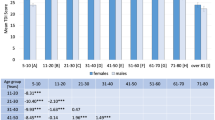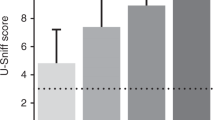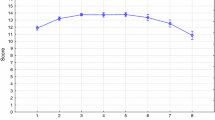Abstract
“Sniffin’ Sticks” is a test of nasal chemosensory function that is based on pen-like odor dispensing devices, introduced some 10 years ago by Kobal and co-workers. It consists of tests for odor threshold, discrimination, and identification. Previous work established its test-retest reliability and validity. Results of the test are presented as “TDI score”, the sum of results obtained for threshold, discrimination, and identification measures. While normative data have been established they are based on a relatively small number of subjects, especially with regard to subjects older than 55 years where data from only 30 healthy subjects have been used. The present study aimed to remedy this situation. Now data are available from 3,282 subjects as compared to data from 738 subjects published previously. Disregarding sex-related differences, the TDI score at the tenth percentile was 24.9 in subjects younger than 15 years, 30.3 for ages from 16 to 35 years, 27.3 for ages from 36 to 55 years, and 19.6 for subjects older than 55 years. Because the tenth percentile has been defined to separate hyposmia from normosmia, these data can be used as a guide to estimate individual olfactory ability in relation to subject’s age. Absolute hyposmia was defined as the tenth percentile score of 16–35 year old subjects. Other than previous reports the present norms are also sex-differentiated with women outperforming men in the three olfactory tests. Further, the present data suggest specific changes of individual olfactory functions in relation to age, with odor thresholds declining most dramatically compared to odor discrimination and odor identification.


Similar content being viewed by others
References
Almkvist O, Berglund B, Nordin S (1992) Odor detectability in successfully aged elderly and young adults. Reports from the Dept. of Psychology, Stockholm University 744:1–12
Betchen SA, Doty RL (1998) Bilateral detection thresholds in dextrals and sinistrals reflect the more sensitive side of the nose, which is not lateralized. Chem Senses 23:453–457
Brand G, Millot JL (2001) Sex differences in human olfaction: between evidence and enigma. Q J Exp Psychol B 54:259–270
Cain WS, Gent JF (1991) Olfactory sensitivity: reliability, generality, and association with aging. J Exp Psychol 17:382–391
Cain WS, Gent JF, Goodspeed RB, Leonard G (1988) Evaluation of olfactory dysfunction in the Connecticut Chemosensory Clinical Research Center (CCCRC). Laryngoscope 98:83–88
Corwin J, Loury M, Gilbert AN (1995) Workplace, age, and sex as mediators of olfactory function: data from the National Geographic Smell Survey. J Gerontol B Psychol Sci Soc Sci 50:P179–186
Dalton P, Doolittle N, Breslin PA (2002) Gender-specific induction of enhanced sensitivity to odors. Nat Neurosci 5:199–200
Doty RL (1986) Gender and endocrine-related influences on human olfactory perception. In: Meiselman R (ed) Clinical measurement of taste and smell. MacMillan, New York, pp 377–413
Doty RL, Applebaum SL, Zusho H, Settle RG (1985) A cross-cultural study on sex differences in odor identification ability. Neuropsychologia 23:667–672
Doty RL, Kerr KL (2005) Episodic odor memory: influences of handedness, sex, and side of nose. Neuropsychologia 43:1749–1753
Doty RL, Marcus A, Lee WW (1996) Development of the 12-item cross-cultural smell identification test (CC-SIT). Laryngoscope 106:353–356
Frasnelli J, Livermore A, Soiffer A, Hummel T (2002) Comparison of lateralized and binasal olfactory thresholds. Rhinology 40:129–134
Hornung DE, Kurtz DB, Bradshaw CB, Seipel DM, Kent PF, Blair DC, Emko P (1998) The olfactory loss that accompanies an HIV infection. Physiol Behav 15:549–556
Hummel T, Barz S, Pauli E, Kobal G (1998) Chemosensory event-related potentials change as a function of age. Electroencephalogr Clin Neurophysiol 108:208–217
Hummel T, Heilmann S, Murphy C (2002) Age-related changes of chemosensory functions. In: Rouby C, Schaal B, Dubois D, Gervais R, Holley A (eds) Olfaction, taste and cognition. Cambridge University Press, New York, pp 441–456
Hummel T, Sekinger B, Wolf S, Pauli E, Kobal G (1997) “Sniffin’ Sticks”: olfactory performance assessed by the combined testing of odor identification, odor discrimination and olfactory threshold. Chem Senses 22:39–52
Hüttenbrink KB (1997) [Disorders of smell and taste. Standard and recent methods in diagnosis and therapy]. Laryngorhinootologie 76:506–514
Jones-Gotman M, Zatorre RJ (1988) Olfactory identification deficits in patients with focal cerebral excision. Neuropsychologia 26:387–400
Kobal G, Hummel T, Sekinger B, Barz S, Roscher S, Wolf S (1996) “Sniffin’ Sticks”: screening of olfactory performance. Rhinology 34:222–226
Kobal G, Klimek L, Wolfensberger M, Gudziol H, Temmel A, Owen CM, Seeber H, Pauli E, Hummel T (2000) Multicenter investigation of 1,036 subjects using a standardized method for the assessment of olfactory function combining tests of odor identification, odor discrimination, and olfactory thresholds. Eur Arch Otorhinolaryngol 257:205–211
Koelega HS, Köster EP (1974) Some experiments on sex differences in odor perception. Ann NY Acad Sci 237:234–246
Larsson M, Lövdén M, Nilsson L-G (2003) Sex differences in recollective experience for olfactory and verbal information. Acta Psychol 112:89–103
Lotsch J, Hummel T (2006) The clinical significance of electrophysiological measures of olfactory function. Behav Brain Res 170:78–83
Lundstrom JN, Frasnelli J, Larsson M, Hummel T (2005) Sex differentiated responses to intranasal trigeminal stimuli. Int J Psychophysiol 57:181–186
Mackay-Sim A, Grant L, Owen C, Chant D, Silburn P (2004) Australian norms for a quantitative olfactory function test. J Clin Neurosci 11:874–879
Moberg PJ, Agrin R, Gur RE, Gur RC, Turetsky BI, Doty RL (1999) Olfactory dysfunction in schizophrenia: a qualitative and quantitative review. Neuropsychopharmacology 21:325–340
Murphy C (1983) Age-related effects on the threshold, psychophysical function, and pleasantness of menthol. J Gerontol 38:217–222
Murphy C, Schubert CR, Cruickshanks KJ, Klein BE, Klein R, Nondahl DM (2002) Prevalence of olfactory impairment in older adults. JAMA 288:2307–2312
Nakashima T, Kimmelman CP, Snow JB Jr, (1984) Structure of human fetal and adult olfactory neuroepithelium. Arch Otolaryngol 110:641–646
Larsson M, Nilsson LG, Olofsson JK, Nordin S (2004) Demographic and cognitive predictors of cued odor identification: evidence from a population-based study. Chem Senses 29:547–54
Rawson NE, Gomez G, Cowart B, Brand JG, Lowry LD, Pribitkin EA, Restrepo D (1997) Selectivity and response characteristics of human olfactory neurons. J Neurophysiol 77:1606–1613
Rosli Y, Breckenridge LJ, Smith RA (1999) An ultrastructural study of age-related changes in mouse olfactory epithelium. J Electron Microsc (Tokyo) 48:77–84
Schaal B, Hummel T, Soussignan R (2004) Olfaction in the fetal and premature infant: functional status and clinical implications. Clin Perinatol 31:261–285
Vaschide N (1904) L’etat de la sensibilite’ olfective dans la vieillesse. Bull Laryngol Otol Rhinol 7:323–333
Venstrom D, Amoore JE (1968) Olfactory threshold in relation to age, sex, or smoking. J Food Sci 33:264–265
Wolfensberger M, Schnieper I, Welge-Lussen A (2000) Sniffin’Sticks: a new olfactory test battery. Acta Otolaryngol 120:303–306
Yousem DM, Maldjian J, Siddiqi F, Hummel T, Alsop D, Geckle RJ, Bilker WB, Doty RL (1998) Gender-effects on odor-stimulated functional magnetic resonance imaging. Brain Res 818:480–487
Yousem DM, Maldjian JA, Hummel T, Alsop DC, Geckle RJ, Kraut MA, Doty RL (1999) The effect of age on odor-stimulated functional MR imaging. Am J Neuroradiol 20:600–608
Mackay-Sim A, Johnston AN, Owen C, Burne TH (2006) Olfactory ability in the healthy population: reassessing presbyosmia. Chem Senses (Epub ahead of print)
Acknowledgments
The authors are indebted to the following individuals, all of whom provided data to the present article: Prof. G. Broich (Department of Otorhinolaryngology, University of the Milano, 20122 Milano, Italy), Dr. A. Welge-Luessen, Dr. I. Schnieper (Department of ORL, University of Basel, 4031 Basel, Switzerland), Dr. P.A. Federspill P.A. (Department of Otorhinolaryngology, University of the Saarland, 66421 Homburg, Germany), Dr. M. Damm (Department of Otorhinolaryngology, University of Cologne, 50924 Cologne, Germany), Dr. B. Hauswald (Department of Otorhinolaryngology, University of Dresden, 01307 Dresden, Germany), O. Opatz (University of Erlangen-Nürnberg Medical School, 91054 Erlangen, Germany), R. Albrecht (Department of Pharmacology, University of Erlangen-Nürnberg, 91054 Erlangen, Germany), A. Soiffer (Smell and Taste Center, University of Pennsylvania, Philadelphia, PA 19104, USA), Dr. S.R. Wolf (Department of ORL, University of Erlangen-Nürnberg, 91054 Erlangen, Germany), Prof. L. Klimek (Department of ORL, University of Mannheim, 55101 Mainz, Germany), Prof. M. Wolfensberger (Department of ORL, University of Basel, 4031 Basel, Switzerland), Prof. A. Temmel (Department of ORL, University of Vienna, 1090 Vienna, Austria), Dr. C. M. Owen (School of Biophysical Sciences and Electrical Engineering, Swinburne University of Technology, 3122 Hawthorn, Australia), Prof. H. Seeber (Clinic of ORL, 06847 Dessau, Germany), Dr. E. Pauli (Department of Neurology, University of Erlangen-Nürnberg, 91054 Erlangen, Germany). Also, the helpful comments of Dr. J. Patterson (Swinburne University of Technology, Hawthorn, Australia) were greatly appreciated. This research was partly supported by DFG grant Ko812/5-1, Germany (Dr. G. Kobal), and grant P01 DC 00161 from the United States National Institute on Deafness and Other Communication Disorders, National Institutes of Health, USA (Dr. R.L. Doty). This research was partly supported by a grant from the Garnett Passe and Rodney Williams Memorial Foundation, Australia (to Dr. A. Mackay-Sim).
Author information
Authors and Affiliations
Corresponding author
Rights and permissions
About this article
Cite this article
Hummel, T., Kobal, G., Gudziol, H. et al. Normative data for the “Sniffin’ Sticks” including tests of odor identification, odor discrimination, and olfactory thresholds: an upgrade based on a group of more than 3,000 subjects. Eur Arch Otorhinolaryngol 264, 237–243 (2007). https://doi.org/10.1007/s00405-006-0173-0
Received:
Accepted:
Published:
Issue Date:
DOI: https://doi.org/10.1007/s00405-006-0173-0




